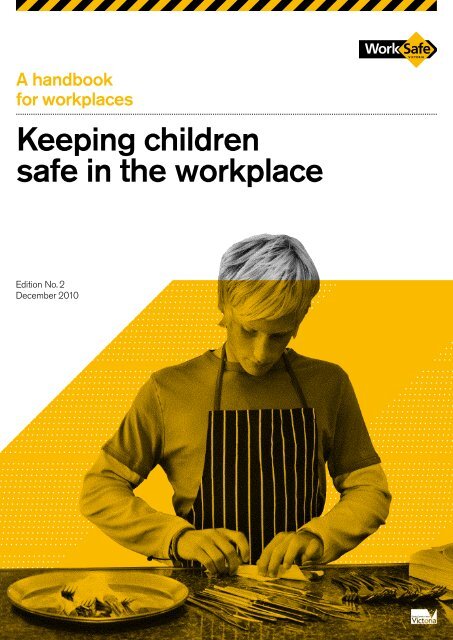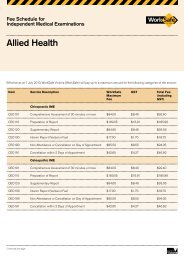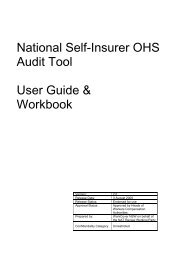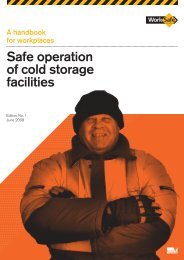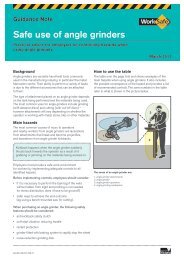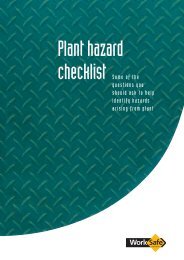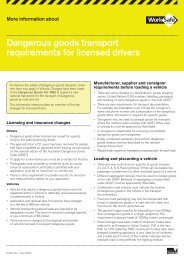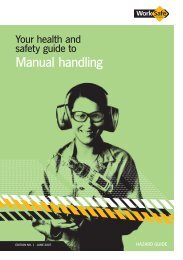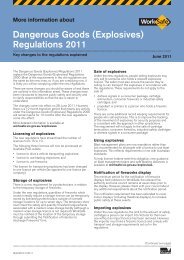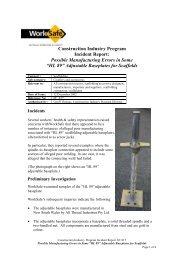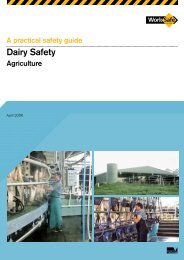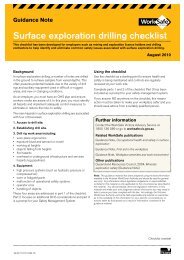Keeping Children Safe in the Workplace (PDF ... - WorkSafe Victoria
Keeping Children Safe in the Workplace (PDF ... - WorkSafe Victoria
Keeping Children Safe in the Workplace (PDF ... - WorkSafe Victoria
Create successful ePaper yourself
Turn your PDF publications into a flip-book with our unique Google optimized e-Paper software.
A handbook<br />
for workplaces<br />
<strong>Keep<strong>in</strong>g</strong> children<br />
safe <strong>in</strong> <strong>the</strong> workplace<br />
Edition No. 2<br />
December 2010
Contents<br />
Introduction 1<br />
1 Background 5<br />
Who is a ‘child’? 5<br />
<strong>Children</strong> <strong>in</strong> workplaces 5<br />
Child <strong>in</strong>juries and deaths <strong>in</strong> <strong>Victoria</strong>n workplaces 5<br />
What is a workplace? 7<br />
2 Health and safety responsibilities 8<br />
What are my responsibilities? 8<br />
Reasonable practicability 8<br />
3 Why children are different 9<br />
What matters should I be aware of? 9<br />
Special risk factors for children 9<br />
4 Mak<strong>in</strong>g preparations for children <strong>in</strong> <strong>the</strong> workplace 11<br />
What should I do when I have children work<strong>in</strong>g <strong>in</strong><br />
my workplace? 11<br />
5 Supervision, <strong>in</strong>duction and tra<strong>in</strong><strong>in</strong>g 13<br />
6 Responsibilities of o<strong>the</strong>rs 14<br />
O<strong>the</strong>r duties 14<br />
What responsibilities do employees have? 14<br />
Do child employees have responsibilities too? 14<br />
7 Acknowledgements and fur<strong>the</strong>r <strong>in</strong>formation 15<br />
The <strong>in</strong>formation presented <strong>in</strong> this<br />
handbook is <strong>in</strong>tended for general use<br />
only. It should not be viewed as a<br />
def<strong>in</strong>itive guide to <strong>the</strong> law, and should be<br />
read <strong>in</strong> conjunction with <strong>the</strong> Occupational<br />
Health and <strong>Safe</strong>ty Act 2004.<br />
Whilst every effort has been made to<br />
ensure <strong>the</strong> accuracy and completeness of<br />
this handbook, <strong>the</strong> advice conta<strong>in</strong>ed<br />
here<strong>in</strong> may not apply <strong>in</strong> every<br />
circumstance. Accord<strong>in</strong>gly, <strong>the</strong> <strong>Victoria</strong>n<br />
WorkCover Authority cannot be held<br />
responsible, and extends no warranties as<br />
to <strong>the</strong> suitability of <strong>the</strong> <strong>in</strong>formation for<br />
your specific circumstances; or actions<br />
taken by third parties as a result of<br />
<strong>in</strong>formation conta<strong>in</strong>ed <strong>in</strong> this handbook.
Introduction<br />
All people <strong>in</strong> <strong>Victoria</strong>n workplaces, <strong>in</strong>clud<strong>in</strong>g children work<strong>in</strong>g <strong>in</strong>, visit<strong>in</strong>g or present <strong>in</strong><br />
a workplace for any reason are protected under <strong>the</strong> Occupational Health and <strong>Safe</strong>ty<br />
Act 2004 (OHS Act).<br />
This guide has been developed to assist those <strong>in</strong> workplaces where children work,<br />
visit or are likely to be present.<br />
It conta<strong>in</strong>s general <strong>in</strong>formation for employers, <strong>the</strong> self-employed, and those who<br />
manage or control workplaces, as well as employees. It may also be of <strong>in</strong>terest<br />
to parents, guardians, teachers and children.<br />
If you employ children now or plan to <strong>in</strong> <strong>the</strong> future, you need to be aware of your<br />
duties under <strong>the</strong> Child Employment Act 2003, adm<strong>in</strong>istered by Workforce <strong>Victoria</strong>.<br />
For more <strong>in</strong>formation on <strong>the</strong>se requirements visit <strong>the</strong> Workforce <strong>Victoria</strong> website<br />
at www.workforce.vic.gov.au<br />
Supported and endorsed by<br />
Workforce <strong>Victoria</strong><br />
Department of Bus<strong>in</strong>ess<br />
and Innovation<br />
Work<strong>Safe</strong> <strong>Victoria</strong> <strong>Keep<strong>in</strong>g</strong> children safe <strong>in</strong> <strong>the</strong> workforce 1
Introduction<br />
The Child Employment Act 2003 regulates <strong>the</strong> employment of children<br />
under <strong>the</strong> age of 15. The Act broadly def<strong>in</strong>es employment to <strong>in</strong>clude both<br />
paid and unpaid work, and applies to a child who is engaged as an employee<br />
or <strong>in</strong>dependent contractor.<br />
Summary of child employment related provisions<br />
Permits<br />
A person must not employ children unless a permit has been issued for<br />
<strong>the</strong> employment.<br />
A permit is not required for a child to work <strong>in</strong> a family bus<strong>in</strong>ess, <strong>in</strong>clud<strong>in</strong>g<br />
a family farm.<br />
The employer must comply with any special conditions relat<strong>in</strong>g to health and safety<br />
detailed on <strong>the</strong> permit. For example, a condition may limit children’s employment to a<br />
particular locality or event or restrict <strong>the</strong> activities or equipment to be used by children<br />
<strong>in</strong> <strong>the</strong> workplace.<br />
<strong>Children</strong> under <strong>the</strong> age of 15 must have a permit to work dur<strong>in</strong>g school hours, after<br />
school hours, on weekends or dur<strong>in</strong>g school holidays, and for certa<strong>in</strong> school work<br />
experience placements.<br />
M<strong>in</strong>imum age<br />
In general, a child must be 13 years old before <strong>the</strong>y can engage <strong>in</strong> any form<br />
of employment.<br />
<strong>Children</strong> may deliver newspapers, pamphlets or o<strong>the</strong>r advertis<strong>in</strong>g material,<br />
or items for a registered pharmacist, from <strong>the</strong> age of 11 years.<br />
The m<strong>in</strong>imum age does not apply to children employed <strong>in</strong> a family bus<strong>in</strong>ess<br />
or <strong>the</strong> enterta<strong>in</strong>ment <strong>in</strong>dustry.<br />
Light work<br />
<strong>Children</strong> are only able to be employed <strong>in</strong> ‘light work’, which is work or any o<strong>the</strong>r<br />
activity not likely to harm <strong>the</strong>ir health or safety, moral or material welfare or development,<br />
nor impact on <strong>the</strong>ir attendance at school or capacity to benefit from <strong>in</strong>struction.<br />
This applies to all children who are work<strong>in</strong>g <strong>in</strong>clud<strong>in</strong>g those work<strong>in</strong>g on family farms,<br />
<strong>in</strong> o<strong>the</strong>r family bus<strong>in</strong>esses, <strong>in</strong> enterta<strong>in</strong>ment, sport<strong>in</strong>g activities, or non-profit organisations.<br />
The follow<strong>in</strong>g types of work or activity are considered likely to be harmful to a child’s<br />
health or safety. The level of risk associated with each should be assessed and<br />
elim<strong>in</strong>ated or reduced where possible.<br />
• repetitive bend<strong>in</strong>g, twist<strong>in</strong>g or lift<strong>in</strong>g<br />
• manually lift<strong>in</strong>g heavy items<br />
• work<strong>in</strong>g with or near cook<strong>in</strong>g or any o<strong>the</strong>r equipment that may produce<br />
high temperatures<br />
• work<strong>in</strong>g with sharp <strong>in</strong>struments or equipment, power-operated tools,<br />
and any o<strong>the</strong>r dangerous equipment<br />
• work<strong>in</strong>g near mov<strong>in</strong>g vehicles<br />
• work<strong>in</strong>g at heights<br />
• work<strong>in</strong>g with uncontrolled animals<br />
• work<strong>in</strong>g <strong>in</strong> extreme wea<strong>the</strong>r conditions.<br />
2 <strong>Keep<strong>in</strong>g</strong> children safe <strong>in</strong> <strong>the</strong> workforce Work<strong>Safe</strong> <strong>Victoria</strong>
Introduction<br />
Hours of work (except when employed <strong>in</strong> a family bus<strong>in</strong>ess<br />
or <strong>in</strong> <strong>the</strong> enterta<strong>in</strong>ment <strong>in</strong>dustry)<br />
The maximum number of hours, <strong>in</strong>clud<strong>in</strong>g rest breaks, a child may work are:<br />
• three hours per day and 12 hours per week dur<strong>in</strong>g <strong>the</strong> school term, and<br />
• six hours per day and 30 hours per week outside <strong>the</strong> school term.<br />
Rest breaks (except when employed <strong>in</strong> a family bus<strong>in</strong>ess or <strong>in</strong><br />
<strong>the</strong> enterta<strong>in</strong>ment <strong>in</strong>dustry)<br />
An employed child must be given a rest break of at least:<br />
• 30 m<strong>in</strong>utes after every 3 hours of work, and<br />
• 12 hours between f<strong>in</strong>ish<strong>in</strong>g one shift and start<strong>in</strong>g <strong>the</strong> next.<br />
Prohibited work<br />
A person must not employ children <strong>in</strong> any of <strong>the</strong> follow<strong>in</strong>g k<strong>in</strong>ds of employment:<br />
• door-to-door sell<strong>in</strong>g<br />
• on a fish<strong>in</strong>g boat, o<strong>the</strong>r than a boat operat<strong>in</strong>g on <strong>in</strong>land waters<br />
• on a build<strong>in</strong>g or construction site (whe<strong>the</strong>r commercial or residential)<br />
at any time before <strong>the</strong> build<strong>in</strong>gs on <strong>the</strong> site are at lock-up stage<br />
• any k<strong>in</strong>d of employment declared to be prohibited.<br />
This prohibition applies to all employment arrangements <strong>in</strong>clud<strong>in</strong>g family bus<strong>in</strong>esses<br />
and non-profit organisations.<br />
Direct supervision<br />
The suitability of direct supervisors (except parents, guardians and extended family<br />
members) is determ<strong>in</strong>ed through a ‘Work<strong>in</strong>g with <strong>Children</strong>’ check.<br />
A parent or guardian must directly supervise a child employed <strong>in</strong> a family bus<strong>in</strong>ess.<br />
An employer of a child must ensure that <strong>the</strong> child is:<br />
• supervised at all times by a person who has an up-to-date ‘Work<strong>in</strong>g with <strong>Children</strong>’<br />
check (or is exempt from this requirement eg teacher, police officer or non-citizens<br />
not usually supervis<strong>in</strong>g children <strong>in</strong> <strong>Victoria</strong>), and<br />
• directly and adequately supervised by such a person at all times <strong>in</strong> <strong>the</strong><br />
employment, hav<strong>in</strong>g regard to:<br />
– nature and environment of <strong>the</strong> workplace, <strong>in</strong>clud<strong>in</strong>g <strong>the</strong> number of children<br />
employed at any one time <strong>in</strong> <strong>the</strong> workplace<br />
– nature of <strong>the</strong> work performed by <strong>the</strong> child, and<br />
– child’s age, sex and physical and emotional development and maturity.<br />
For more <strong>in</strong>formation see Workforce <strong>Victoria</strong>’s guide, Child employment and<br />
work<strong>in</strong>g with children checks.<br />
Work<strong>Safe</strong> <strong>Victoria</strong> <strong>Keep<strong>in</strong>g</strong> children safe <strong>in</strong> <strong>the</strong> workforce 3
Introduction<br />
Enterta<strong>in</strong>ment <strong>in</strong>dustry<br />
In order to more appropriately regulate <strong>the</strong> employment of children <strong>in</strong> <strong>the</strong><br />
enterta<strong>in</strong>ment <strong>in</strong>dustry, <strong>the</strong> M<strong>in</strong>ister for Industrial Relations made <strong>the</strong> Mandatory<br />
Code of Practice for <strong>the</strong> Employment of <strong>Children</strong> <strong>in</strong> Enterta<strong>in</strong>ment under section 29<br />
of <strong>the</strong> Child Employment Act 2003. The Code regulates matters such as:<br />
• daily hours of work<br />
• spread of hours<br />
• shifts and rest breaks<br />
• provision of education<br />
• a 40-hour limit on comb<strong>in</strong>ed work and education<br />
• travel<br />
• food, dr<strong>in</strong>k and amenities<br />
• parental contact<br />
• supervision<br />
• <strong>in</strong>appropriate roles or situations<br />
• specific provisions for babies.<br />
For more <strong>in</strong>formation, contact a Child Employment Officer at Workforce <strong>Victoria</strong><br />
on 1800 287 287.<br />
4 <strong>Keep<strong>in</strong>g</strong> children safe <strong>in</strong> <strong>the</strong> workforce Work<strong>Safe</strong> <strong>Victoria</strong>
1.<br />
Background<br />
This guidance considers all those<br />
aged under 15 as a child. However,<br />
much of <strong>the</strong> <strong>in</strong>formation conta<strong>in</strong>ed<br />
<strong>in</strong> this guide is also relevant to<br />
adolescents older than 15.<br />
Who is a ‘child’?<br />
This guidance considers all those aged under 15 as a child. However, much of<br />
<strong>the</strong> <strong>in</strong>formation conta<strong>in</strong>ed <strong>in</strong> this guide is also relevant to adolescents older than 15.<br />
<strong>Children</strong> <strong>in</strong> workplaces<br />
In <strong>the</strong> past it was common for some children under 15 to have part-time jobs<br />
or to help <strong>in</strong> family bus<strong>in</strong>esses such as farms and shops. <strong>Children</strong> were likely<br />
to be employed deliver<strong>in</strong>g papers, babysitt<strong>in</strong>g, street sell<strong>in</strong>g or clean<strong>in</strong>g.<br />
Today, however, more children are likely to be work<strong>in</strong>g more regularly and for longer<br />
periods of time <strong>in</strong> a much wider range of jobs, such as:<br />
• fast food outlets<br />
• TV, film and advertis<strong>in</strong>g sets<br />
• supermarkets<br />
• restaurants and cafes<br />
• department stores<br />
• factories<br />
• major events.<br />
Child <strong>in</strong>juries and deaths <strong>in</strong> <strong>Victoria</strong>n workplaces<br />
<strong>Children</strong>, like o<strong>the</strong>r employees, may be exposed to health and safety risks.<br />
Compensation claims data shows that children under <strong>the</strong> age of 15 are regularly<br />
<strong>in</strong>jured <strong>in</strong> <strong>Victoria</strong>n workplaces. Injuries <strong>in</strong>clude fractures, spra<strong>in</strong>s and stra<strong>in</strong>s, open<br />
wounds, burns, contusions and crush<strong>in</strong>gs. Often <strong>the</strong>se <strong>in</strong>juries are caused by trips,<br />
slips and falls, hitt<strong>in</strong>g objects, be<strong>in</strong>g hit by mov<strong>in</strong>g objects, and body stress<strong>in</strong>g.<br />
Mostly <strong>the</strong>se <strong>in</strong>juries are to hands and f<strong>in</strong>gers, back, shoulder, arm, wrist and head.<br />
Regretfully, each year children die from work-related <strong>in</strong>cidents. There were 28 child<br />
fatalities between 1990 and 2009. Most of <strong>the</strong>se occurred on family owned farms,<br />
with <strong>the</strong> children ei<strong>the</strong>r family members or visitors. (You can f<strong>in</strong>d more <strong>in</strong>formation<br />
about farm safety at worksafe.vic.gov.au). The follow<strong>in</strong>g cases are adapted from<br />
<strong>in</strong>cidents <strong>in</strong> Australia and overseas.<br />
Work<strong>Safe</strong> <strong>Victoria</strong> <strong>Keep<strong>in</strong>g</strong> children safe <strong>in</strong> <strong>the</strong> workforce 5
1.<br />
Background<br />
<strong>Children</strong>, like o<strong>the</strong>r employees,<br />
may be exposed to health and<br />
safety risks.<br />
Case one<br />
A three-year-old boy was play<strong>in</strong>g <strong>in</strong> <strong>the</strong> kitchen of his parents’ restaurant while<br />
<strong>the</strong>y prepared for trade.<br />
When a cook went to get o<strong>the</strong>r <strong>in</strong>gredients <strong>the</strong> boy tried to snatch peanuts out<br />
of an electric m<strong>in</strong>c<strong>in</strong>g mach<strong>in</strong>e.<br />
Unfortunately, his f<strong>in</strong>gers were trapped as he reached down <strong>the</strong> funnel. As his<br />
hand could not be freed he was rushed to hospital with <strong>the</strong> mach<strong>in</strong>e still attached.<br />
The boy’s f<strong>in</strong>gers were too badly damaged to be repaired and were amputated.<br />
Case two<br />
A 13-year-old girl worked <strong>in</strong> her uncle’s beachside ice cream shop dur<strong>in</strong>g <strong>the</strong><br />
summer holidays.<br />
As she was short, she had to stand on tip toes to reach <strong>the</strong> conta<strong>in</strong>ers and use<br />
force to scoop up <strong>the</strong> hard ice cream.<br />
Soon, her right shoulder, arm and wrist became very sore and she required several<br />
months of rest and physio<strong>the</strong>rapy to recover from <strong>the</strong> <strong>in</strong>jury.<br />
Case three<br />
Several small boys climbed through a gap <strong>in</strong> a fence around a construction site<br />
after <strong>the</strong> builders went home.<br />
Once <strong>in</strong>side, <strong>the</strong>y played <strong>in</strong> and around partly constructed build<strong>in</strong>gs, f<strong>in</strong>d<strong>in</strong>g a stack<br />
of large concrete pipes to crawl through.<br />
As one boy climbed out, he stumbled and fell aga<strong>in</strong>st a pipe caus<strong>in</strong>g it to move<br />
slightly. The whole stack <strong>the</strong>n rolled, crush<strong>in</strong>g one of <strong>the</strong> boys, who later died<br />
<strong>in</strong> hospital from his <strong>in</strong>juries.<br />
Case four<br />
A 14-year-old girl worked part-time at a café where <strong>the</strong> owner’s friends were<br />
regular patrons.<br />
One began to touch her whenever she cleared <strong>the</strong>ir table or took <strong>the</strong>ir orders.<br />
Though embarrassed, she did not know what to do and <strong>the</strong> man did not stop.<br />
F<strong>in</strong>ally she told <strong>the</strong> owner, who said his friend was just teas<strong>in</strong>g and he didn’t want<br />
to hear compla<strong>in</strong>ts about good customers.<br />
One day <strong>the</strong> man was wait<strong>in</strong>g for <strong>the</strong> girl after her shift and tried to persuade her<br />
to get <strong>in</strong>to his car. She ran home and told her parents who reported <strong>the</strong> matter to<br />
<strong>the</strong> police.<br />
Case five<br />
A farmer asked his 12-year-old son to check <strong>the</strong> farm gates were closed, as a<br />
neighbour had phoned to say cattle were on <strong>the</strong> public road. The boy took <strong>the</strong> quad<br />
bike <strong>in</strong>stead of his bicycle, and apparently went across <strong>the</strong> paddock to practice<br />
driv<strong>in</strong>g between some shade trees on his way back from check<strong>in</strong>g <strong>the</strong> gates.<br />
When he had not returned after an hour, his fa<strong>the</strong>r went to check and saw <strong>the</strong> quad<br />
bike but not his son. He ran to <strong>the</strong> trees and found <strong>the</strong> quad bike had hit a branch<br />
hidden <strong>in</strong> long grass and <strong>the</strong> boy had been thrown off. As he was not wear<strong>in</strong>g a<br />
helmet he received head <strong>in</strong>juries and needed several months to recover before he<br />
could return to school.<br />
6 <strong>Keep<strong>in</strong>g</strong> children safe <strong>in</strong> <strong>the</strong> workforce Work<strong>Safe</strong> <strong>Victoria</strong>
1.<br />
Background<br />
If you are an employer, self-employed,<br />
or a person who owns, manages or<br />
controls a workplace, ask yourself:<br />
‘Is <strong>the</strong>re any chance that a child will<br />
be <strong>in</strong> my workplace, for any reason,<br />
at any time?’<br />
What is a workplace?<br />
A workplace is a place where employees or self-employed persons work, whe<strong>the</strong>r<br />
<strong>in</strong> a build<strong>in</strong>g or structure or not. This can be almost anywhere: a paddock, a build<strong>in</strong>g,<br />
a truck, a family’s home, a tent, a park, a sports ground or a boat.<br />
If a child is deliver<strong>in</strong>g newspapers, for example, <strong>the</strong> workplace is <strong>the</strong> route <strong>the</strong> child<br />
has to take and where <strong>the</strong> child is at any given time.<br />
<strong>Children</strong> <strong>in</strong> workplaces are protected by health and safety laws<br />
even if <strong>the</strong>y are not employees. For example, <strong>the</strong>y may:<br />
• live on a farm or at a place where a bus<strong>in</strong>ess or family bus<strong>in</strong>ess is conducted<br />
• enter <strong>the</strong> workplace with family members who may be <strong>the</strong> employer or an<br />
employee (eg dur<strong>in</strong>g or after work, <strong>in</strong> school holidays, for work Christmas<br />
parties etc.)<br />
• ride <strong>in</strong> a truck or o<strong>the</strong>r vehicles be<strong>in</strong>g used for work<br />
• be a student <strong>in</strong> a school, a patient <strong>in</strong> a hospital or a customer <strong>in</strong> a shop<br />
• enter a workplace such as a construction site, factory or workshop when <strong>the</strong><br />
employees have gone home<br />
• enter a backyard workshop of a self-employed person who works from home.<br />
If you are an employer, self-employed, or a person who owns, manages or controls<br />
a workplace, ask yourself:<br />
‘Is <strong>the</strong>re any chance that a child will be <strong>in</strong> my workplace, for any reason,<br />
at any time?’<br />
If you answer ‘yes’, you must consider <strong>the</strong> presence or likely presence of children<br />
<strong>in</strong> your workplace when you are identify<strong>in</strong>g hazards and controll<strong>in</strong>g risks.<br />
Work<strong>Safe</strong> <strong>Victoria</strong> <strong>Keep<strong>in</strong>g</strong> children safe <strong>in</strong> <strong>the</strong> workforce 7
2.<br />
Health and safety<br />
responsibilities<br />
What are my responsibilities?<br />
If you are an employer, under <strong>the</strong> OHS Act you have a duty to provide and ma<strong>in</strong>ta<strong>in</strong><br />
a work<strong>in</strong>g environment that is safe and poses no risks to health, so far<br />
as is reasonably practicable.<br />
The OHS Act also requires you to ensure, so far as is reasonably practicable,<br />
that persons o<strong>the</strong>r than your employees are not exposed to risks to <strong>the</strong>ir health<br />
or safety aris<strong>in</strong>g from activities be<strong>in</strong>g undertaken <strong>in</strong> <strong>the</strong> workplace.<br />
If you are self-employed you have a duty to ensure people are not exposed to<br />
health or safety risks aris<strong>in</strong>g from activities be<strong>in</strong>g undertaken <strong>in</strong> your workplace.<br />
For example, if it is likely children may be able to enter a workplace dur<strong>in</strong>g or after<br />
work<strong>in</strong>g hours, you should ensure so far as is reasonably practicable that your<br />
workplace is made secure.<br />
If you manage or control a workplace you are required, so far as is reasonably<br />
practicable, to ensure that <strong>the</strong> workplace and <strong>the</strong> means of enter<strong>in</strong>g and leav<strong>in</strong>g<br />
it, are safe and pose no risks to health and safety.<br />
The OHS Act provides for <strong>the</strong> protection of children who are employed at a<br />
workplace, as well as children who are <strong>in</strong> or near a workplace for any o<strong>the</strong>r reason.<br />
Reasonable practicability<br />
Many duties under <strong>the</strong> OHS Act and regulations are qualified by ‘so far as is<br />
reasonably practicable’.<br />
To comply with duties to ensure health and safety, you must consider <strong>the</strong> follow<strong>in</strong>g<br />
when you assess what is ‘reasonably practicable’:<br />
• <strong>the</strong> likelihood of <strong>the</strong> hazard or risk eventuat<strong>in</strong>g<br />
• <strong>the</strong> degree of harm that would result if <strong>the</strong> hazard or risk eventuated<br />
• what you know, or ought reasonably know, about <strong>the</strong> hazard or risk and any ways<br />
of elim<strong>in</strong>at<strong>in</strong>g or reduc<strong>in</strong>g <strong>the</strong>se<br />
• <strong>the</strong> availability and suitability of ways to elim<strong>in</strong>ate or reduce <strong>the</strong> hazard or risk<br />
• <strong>the</strong> cost of elim<strong>in</strong>at<strong>in</strong>g or reduc<strong>in</strong>g <strong>the</strong> hazard or risk.<br />
When review<strong>in</strong>g your risk management systems before children beg<strong>in</strong> work, you need<br />
to consider what is reasonably practicable, consider<strong>in</strong>g all special risk factors.<br />
You also need to consider <strong>the</strong>se matters at all times when you employ children,<br />
not just before <strong>the</strong>y start work.<br />
8 <strong>Keep<strong>in</strong>g</strong> children safe <strong>in</strong> <strong>the</strong> workforce Work<strong>Safe</strong> <strong>Victoria</strong>
3.<br />
Why children<br />
are different<br />
What matters should I be aware of?<br />
When comply<strong>in</strong>g with duties under <strong>the</strong> OHS Act and regulations to ensure health and<br />
safety, you are required to elim<strong>in</strong>ate health and safety risks, or reduce those risks so<br />
far as is reasonably practicable.<br />
You should be aware that <strong>the</strong> risk management processes you have to safeguard<br />
adult employees may not adequately protect children.<br />
Most workplaces and jobs are established <strong>in</strong> <strong>the</strong> expectation that adults with <strong>the</strong><br />
appropriate physical and mental capacities, skills, tra<strong>in</strong><strong>in</strong>g and experience will do <strong>the</strong><br />
work. If <strong>the</strong>re are child employees <strong>in</strong> <strong>the</strong> workplace, it is unlikely <strong>the</strong>y will be able to<br />
do <strong>the</strong> same work as adults <strong>in</strong> <strong>the</strong> same way. As such, children should not be<br />
substituted for adult workers.<br />
Special risk factors for children<br />
The age of <strong>the</strong> child should be considered as a specific risk factor when identify<strong>in</strong>g<br />
hazards and controll<strong>in</strong>g risks.<br />
It is important to be aware that <strong>in</strong> work situations, some hazards pose a higher risk to<br />
children than adults. When <strong>in</strong>cidents happen, <strong>the</strong> consequences can be very severe.<br />
Work<strong>Safe</strong> <strong>Victoria</strong> has <strong>in</strong>vestigated <strong>in</strong>cidents <strong>in</strong>volv<strong>in</strong>g children that have resulted <strong>in</strong><br />
very serious <strong>in</strong>juries and even fatalities.<br />
Work<strong>Safe</strong> <strong>Victoria</strong> <strong>Keep<strong>in</strong>g</strong> children safe <strong>in</strong> <strong>the</strong> workforce 9
3.<br />
Why children are different<br />
You should also be aware children:<br />
• do not possess experience, knowledge or judgment about workplace hazards<br />
and safe work practices<br />
• are unlikely to know if <strong>the</strong>y are be<strong>in</strong>g exposed to health and safety risks and<br />
may f<strong>in</strong>d it hard to speak up even if <strong>the</strong>y do<br />
• may be energetic and enthusiastic, but shy about ask<strong>in</strong>g questions or mak<strong>in</strong>g<br />
demands of adults<br />
• may do work <strong>the</strong>y are not prepared for nor capable of do<strong>in</strong>g safely because<br />
<strong>the</strong>y are used to be<strong>in</strong>g told what to do by adults<br />
• are often keen to please so <strong>the</strong>y might try to imitate what <strong>the</strong>y see adults do<strong>in</strong>g<br />
• may skylark near mach<strong>in</strong>ery or chemicals etc. without realis<strong>in</strong>g <strong>the</strong> risks <strong>in</strong>volved<br />
• can be <strong>in</strong>quisitive and adventurous and <strong>the</strong>ir natural curiosity may lead <strong>the</strong>m <strong>in</strong>to<br />
dangerous situations <strong>in</strong> workplaces<br />
• do not have <strong>the</strong> experience and maturity to respond appropriately <strong>in</strong> unexpected,<br />
dangerous or stressful situations, such as when customers become aggressive<br />
or <strong>the</strong>re is <strong>the</strong> threat of violence<br />
• may be vulnerable to pranks and teas<strong>in</strong>g by adult workers tak<strong>in</strong>g advantage<br />
of <strong>the</strong>ir <strong>in</strong>experience and <strong>in</strong>nocence<br />
• may be vulnerable to bully<strong>in</strong>g and harassment<br />
• are still grow<strong>in</strong>g and will be comparatively weaker and have less stam<strong>in</strong>a<br />
than adults.<br />
10 <strong>Keep<strong>in</strong>g</strong> children safe <strong>in</strong> <strong>the</strong> workforce Work<strong>Safe</strong> <strong>Victoria</strong>
4.<br />
Mak<strong>in</strong>g<br />
preparations for<br />
children <strong>in</strong> <strong>the</strong><br />
workplace<br />
What should I do when I have children work<strong>in</strong>g <strong>in</strong><br />
my workplace?<br />
<strong>Workplace</strong>s should be safe for all employees, however, because of <strong>the</strong> special risk<br />
factors for children, <strong>the</strong>y require special attention and prevention efforts need be<br />
targeted specifically to <strong>the</strong>m.<br />
It is important to consult with your employees and any health and safety<br />
representative (HSR) about br<strong>in</strong>g<strong>in</strong>g children to <strong>the</strong> workplace and ga<strong>in</strong> <strong>the</strong>ir views<br />
on possible hazards.<br />
You should prepare for child employees by:<br />
• identify<strong>in</strong>g hazards and elim<strong>in</strong>at<strong>in</strong>g <strong>the</strong>m by redesign<strong>in</strong>g <strong>the</strong> workplace or<br />
work processes<br />
• controll<strong>in</strong>g risks <strong>in</strong> <strong>in</strong>stances when <strong>the</strong>y cannot be elim<strong>in</strong>ated<br />
• review<strong>in</strong>g risk management systems and all work practices, ensur<strong>in</strong>g safe<br />
systems of work are <strong>in</strong> place and ma<strong>in</strong>ta<strong>in</strong>ed<br />
• review<strong>in</strong>g workplace policies and procedures and amend<strong>in</strong>g <strong>the</strong>m<br />
where necessary<br />
• discuss<strong>in</strong>g <strong>the</strong> risks to children and <strong>the</strong>ir specific needs <strong>in</strong> <strong>the</strong> workplace with<br />
adult employees<br />
• encourag<strong>in</strong>g adult employees to support children by keep<strong>in</strong>g an eye out for<br />
<strong>the</strong>m and how <strong>the</strong>y are manag<strong>in</strong>g <strong>the</strong> work<br />
• identify<strong>in</strong>g and appo<strong>in</strong>t<strong>in</strong>g a person with appropriate skills, experience and an<br />
up-to-date ‘Work<strong>in</strong>g with <strong>Children</strong>’ check to be <strong>the</strong> child’s direct supervisor.<br />
Work<strong>Safe</strong> <strong>Victoria</strong> <strong>Keep<strong>in</strong>g</strong> children safe <strong>in</strong> <strong>the</strong> workforce 11
4.<br />
Mak<strong>in</strong>g preparations for children<br />
<strong>in</strong> <strong>the</strong> workplace<br />
Employees, <strong>in</strong>clud<strong>in</strong>g children, must<br />
be consulted when you are<br />
identify<strong>in</strong>g hazards and controll<strong>in</strong>g<br />
risks. If <strong>the</strong>re is a HSR <strong>the</strong>y must<br />
also be <strong>in</strong>volved <strong>in</strong> <strong>the</strong> consultation.<br />
You should also ask yourself <strong>the</strong> follow<strong>in</strong>g questions:<br />
Are <strong>the</strong> duties be<strong>in</strong>g performed by <strong>the</strong> child ‘light work’ as def<strong>in</strong>ed<br />
<strong>in</strong> <strong>the</strong> Child Employment Act 2003?<br />
Will <strong>the</strong> children have <strong>the</strong> physical strength to carry out <strong>the</strong> tasks?<br />
Will <strong>the</strong> children have <strong>the</strong> stam<strong>in</strong>a to work at <strong>the</strong> tasks for <strong>the</strong> required<br />
period of time?<br />
Will <strong>the</strong> children be able to concentrate on <strong>the</strong> task for <strong>the</strong> required<br />
period of time?<br />
Will <strong>the</strong> children be work<strong>in</strong>g at jobs that might expose <strong>the</strong>m to <strong>the</strong> risk of<br />
stra<strong>in</strong>s, spra<strong>in</strong>s and over-use <strong>in</strong>jury? If so, have manual handl<strong>in</strong>g hazards<br />
and risks been identified and controlled?<br />
Will <strong>the</strong> children be us<strong>in</strong>g any plant? If so, have plant hazards<br />
and risks been identified and controlled? For example:<br />
• will <strong>the</strong>y be able to reach all parts of <strong>the</strong> mach<strong>in</strong>es <strong>the</strong>y may need<br />
to use?<br />
• will <strong>the</strong>y be able to put <strong>the</strong>ir hands through gaps <strong>in</strong> guard<strong>in</strong>g that<br />
is adequate to protect adults?<br />
• will <strong>the</strong>y be able to hold and use hand held plant properly?<br />
Will <strong>the</strong> children be work<strong>in</strong>g <strong>in</strong> a noisy environment? If so, have noise<br />
exposure hazards and risks been identified and controlled?<br />
Will children be exposed to extremes of temperatures?<br />
If so, have temperature hazards and risks been controlled?<br />
Will children be do<strong>in</strong>g any work at heights (eg <strong>in</strong> <strong>the</strong> enterta<strong>in</strong>ment <strong>in</strong>dustry)?<br />
If so, have falls hazards and risks been identified and controlled?<br />
Will children be work<strong>in</strong>g with chemicals or where chemicals are be<strong>in</strong>g used?<br />
If so, have hazardous substances hazards and risks been identified and<br />
controlled? For example:<br />
• will children be likely to be <strong>in</strong> a workplace or have access to a<br />
workplace where lead processes are tak<strong>in</strong>g place (eg radiator<br />
repair shops)?<br />
• will children be us<strong>in</strong>g clean<strong>in</strong>g chemicals?<br />
When answer<strong>in</strong>g all <strong>the</strong> questions above, <strong>the</strong> child employee’s age and stage<br />
of development must be considered.<br />
Tasks <strong>the</strong> children will be do<strong>in</strong>g should be considered so that any hazards<br />
which pose risks to health and safety can be identified, and <strong>the</strong> risks<br />
elim<strong>in</strong>ated or reduced so far as is practicable. This relates to all hazards,<br />
not just those for which <strong>the</strong>re are regulations.<br />
Employees, <strong>in</strong>clud<strong>in</strong>g children, must be consulted when you are identify<strong>in</strong>g hazards<br />
and controll<strong>in</strong>g risks. If <strong>the</strong>re is a HSR <strong>the</strong>y must also be <strong>in</strong>volved <strong>in</strong> <strong>the</strong> consultation.<br />
You should also discuss all <strong>the</strong>se matters and provide <strong>in</strong>formation about hazards,<br />
risks and risk controls to <strong>the</strong> children’s parents, guardians, and teachers, as well<br />
as <strong>the</strong> children <strong>the</strong>mselves.<br />
12 <strong>Keep<strong>in</strong>g</strong> children safe <strong>in</strong> <strong>the</strong> workforce Work<strong>Safe</strong> <strong>Victoria</strong>
5.<br />
Supervision,<br />
<strong>in</strong>duction<br />
and tra<strong>in</strong><strong>in</strong>g<br />
If you regularly employ children, or<br />
are consider<strong>in</strong>g employ<strong>in</strong>g children<br />
or offer<strong>in</strong>g work experience<br />
placements to school students,<br />
you should develop a policy that<br />
details how children will be<br />
<strong>in</strong>ducted, tra<strong>in</strong>ed and supervised.<br />
Supervision, <strong>in</strong>duction and tra<strong>in</strong><strong>in</strong>g<br />
If you regularly employ children, or are consider<strong>in</strong>g employ<strong>in</strong>g children or offer<strong>in</strong>g<br />
work experience placements to school students, you should develop a policy that<br />
details how children will be <strong>in</strong>ducted, tra<strong>in</strong>ed and supervised.<br />
The policy should be developed <strong>in</strong> consultation with employees and any HSR,<br />
or with <strong>the</strong> employees where <strong>the</strong>re is no HSR. You should provide <strong>the</strong> policy to<br />
parents, guardians, teachers and children for <strong>the</strong>ir <strong>in</strong>formation and for discussion.<br />
The suitability of supervisors (except parents, guardians and extended family<br />
members) is determ<strong>in</strong>ed through a ‘Work<strong>in</strong>g with <strong>Children</strong>’ check. See pages 2-3<br />
of this guide for more <strong>in</strong>formation on supervis<strong>in</strong>g children.<br />
When children beg<strong>in</strong> work, you should:<br />
• talk to <strong>the</strong>m about health and safety<br />
• <strong>in</strong>troduce <strong>the</strong>m to <strong>the</strong>ir direct supervisor, any HSR as well as o<strong>the</strong>r employees,<br />
and expla<strong>in</strong> what <strong>the</strong> supervisor and HSR roles are<br />
• before <strong>the</strong> child beg<strong>in</strong>s work, give <strong>the</strong>m a full <strong>in</strong>duction on <strong>the</strong> safety systems<br />
<strong>in</strong>clud<strong>in</strong>g first aid, emergency procedures, and <strong>in</strong>cident report<strong>in</strong>g<br />
• check regularly to ensure that <strong>the</strong> children remember this <strong>in</strong>formation<br />
• show <strong>the</strong> children <strong>the</strong> safe work practices for <strong>the</strong> job and make sure <strong>the</strong>y<br />
can do <strong>the</strong> work us<strong>in</strong>g <strong>the</strong> demonstrated practices<br />
• regularly check that <strong>the</strong> children still recognise hazards and risks and use <strong>the</strong> safe<br />
work practices <strong>the</strong>y were shown<br />
• regularly <strong>in</strong>spect and ma<strong>in</strong>ta<strong>in</strong> equipment that children may need to use to ensure<br />
it is safe<br />
• ensure that <strong>in</strong>formation about health and safety requirements is prom<strong>in</strong>ently<br />
displayed where all employees can easily read it.<br />
All <strong>in</strong>cidents prescribed <strong>in</strong> Part 5 of <strong>the</strong> OHS Act should be reported to<br />
Work<strong>Safe</strong> <strong>Victoria</strong>.<br />
Work<strong>Safe</strong> <strong>Victoria</strong> <strong>Keep<strong>in</strong>g</strong> children safe <strong>in</strong> <strong>the</strong> workforce 13
6.<br />
Responsibilities<br />
of o<strong>the</strong>rs<br />
O<strong>the</strong>r duties<br />
The OHS Act also puts a duty on persons to not engage <strong>in</strong> reckless conduct that<br />
may place ano<strong>the</strong>r person at a workplace <strong>in</strong> danger of serious <strong>in</strong>jury.<br />
You need to ensure that any person who may be <strong>in</strong> your workplace is aware of <strong>the</strong>ir<br />
responsibilities. For example, you may have a policy for contractors, suppliers or<br />
visitors as well as your own employees on site entry and behaviour <strong>in</strong> <strong>the</strong> workplace.<br />
What responsibilities do employees have?<br />
Employees have certa<strong>in</strong> responsibilities for health and safety <strong>in</strong> <strong>the</strong> workplace, <strong>in</strong>clud<strong>in</strong>g:<br />
• tak<strong>in</strong>g reasonable care for <strong>the</strong>ir own health and safety<br />
• tak<strong>in</strong>g reasonable care for <strong>the</strong> health and safety of o<strong>the</strong>rs <strong>in</strong> <strong>the</strong> workplace who<br />
may be affected by what employees do or do not do<br />
• co-operat<strong>in</strong>g <strong>in</strong> actions taken to comply with health and safety requirements<br />
(such as wear<strong>in</strong>g personal protective equipment, follow<strong>in</strong>g work practices and<br />
procedures etc.)<br />
• not wilfully or recklessly <strong>in</strong>terfer<strong>in</strong>g or misus<strong>in</strong>g anyth<strong>in</strong>g provided <strong>in</strong> <strong>the</strong> <strong>in</strong>terests<br />
of health and safety.<br />
Do child employees have responsibilities too?<br />
Employed children have responsibilities to work safely and not harm <strong>the</strong>mselves or<br />
o<strong>the</strong>rs, <strong>the</strong> same as o<strong>the</strong>r employees. However, like o<strong>the</strong>r employees, this duty is<br />
limited by what children know about <strong>the</strong> circumstances.<br />
You should realise <strong>the</strong>re are limits to what work children can safely do,<br />
as well as how well <strong>the</strong>y can understand concepts such as hazards and risks.<br />
You should not expect <strong>the</strong> same understand<strong>in</strong>g or responsibility from<br />
a child as you would from an adult. In particular, if you are employ<strong>in</strong>g children<br />
under school age and school children <strong>in</strong> <strong>the</strong> early school grades, such as young<br />
actors and models, <strong>the</strong>y cannot be expected to understand and fulfil <strong>the</strong><br />
employee responsibilities.<br />
Consequently, you should be aware that <strong>the</strong> health and safety of child employees<br />
as far as reasonably practicable will be more difficult than provid<strong>in</strong>g <strong>the</strong> same level<br />
of protection for protection for adult employees. However you must protect <strong>the</strong><br />
health and safety of child employees under <strong>the</strong> age of 15.<br />
14 <strong>Keep<strong>in</strong>g</strong> children safe <strong>in</strong> <strong>the</strong> workforce Work<strong>Safe</strong> <strong>Victoria</strong>
7.<br />
Acknowledgements<br />
and fur<strong>the</strong>r<br />
<strong>in</strong>formation<br />
Work<strong>Safe</strong> <strong>Victoria</strong> acknowledges <strong>the</strong> Work<strong>Safe</strong> Western Australia Commission Code<br />
of Practice for <strong>the</strong> Health and <strong>Safe</strong>ty of Young People <strong>in</strong> <strong>Workplace</strong>s as a source of<br />
<strong>in</strong>formation for this publication.<br />
Work<strong>Safe</strong> <strong>Victoria</strong><br />
Work<strong>Safe</strong> <strong>Victoria</strong> offers a complete range of OHS services <strong>in</strong>clud<strong>in</strong>g emergency<br />
response, advice, <strong>in</strong>formation and education, <strong>in</strong>spections and audits, licens<strong>in</strong>g and<br />
certification, publications, and onl<strong>in</strong>e guidance.<br />
Work<strong>Safe</strong> <strong>Victoria</strong> publications can be downloaded from worksafe.vic.gov.au<br />
Work<strong>Safe</strong> <strong>Victoria</strong> <strong>Keep<strong>in</strong>g</strong> children safe <strong>in</strong> <strong>the</strong> workforce 15
Notes<br />
16 <strong>Keep<strong>in</strong>g</strong> children safe <strong>in</strong> <strong>the</strong> workforce Work<strong>Safe</strong> <strong>Victoria</strong>
Work<strong>Safe</strong> <strong>Victoria</strong><br />
Advisory Service<br />
222 Exhibition Street<br />
Melbourne 3000<br />
Phone 03 9641 1444<br />
Toll-free 1800 136 089<br />
Email <strong>in</strong>fo@worksafe.vic.gov.au<br />
Head Office<br />
222 Exhibition Street<br />
Melbourne 3000<br />
Phone 03 9641 1555<br />
Toll-free 1800 136 089<br />
Website worksafe.vic.gov.au<br />
Workforce <strong>Victoria</strong><br />
Department of Bus<strong>in</strong>ess<br />
and Innovation<br />
Level 33, 121 Exhibition Sreet<br />
Melbourne 3000<br />
GPO Box 4509, Melbourne 3001<br />
Phone 1800 287 287<br />
Fax 9651 9703<br />
Website workforce.vic.gov.au<br />
Local Offices<br />
Ballarat 03 5338 4444<br />
Bendigo 03 5443 8866<br />
Dandenong 03 8792 9000<br />
Geelong 03 5226 1200<br />
Melbourne<br />
(628 Bourke Street) 03 9941 0558<br />
Mildura 03 5021 4001<br />
Mulgrave 03 9565 9444<br />
Preston 03 9485 4555<br />
Shepparton 03 5831 8260<br />
Traralgon 03 5174 8900<br />
Wangaratta 03 5721 8588<br />
Warrnambool 03 5564 3200<br />
WSV1070/02/12.10


